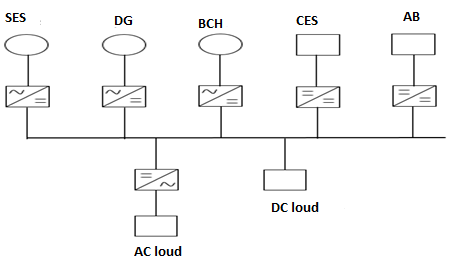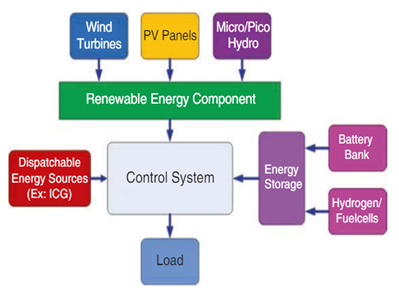Energy systems are playing a major role in day-to-day life. It may be your refrigerator, air conditioner, power generator that you use to get electricity, etc. that we discuss. It is prudent that though we use power and energy, very few of us are con-cerned on energy conservation. Even though we always try to match it with financial aspects, I feel that there is something more on it especially when considering the social responsibility. Fossil fuel resources are depleting at a rapid speed, and at the same time, we are facing lots of problems created by the emission of fossil fuel combustion. Therefore, we are in a period where special attention should be given to conservation of energy Sustainable energy supply, especially in rural and remote areas, is one of the most important problems in the development of power supply systems of the Republic. In recent years, a fairly large number of developments have been proposed that provide sustainable energy supply to facilities using the so-called hybrid energy systems based on renewable energy sources (RES). This concept is most widely used in relation to the energy supply of rural areas and to the autonomous power supply of remote objects, for example, base stations of mobile communications, hydrometeorological stations, small remote objects, etc.
Hybrid power supply systems integrate a centralized electric network and several renewable energy sources: solar panels (SES), mini-hydroelectric power stations, wind turbines (wind power plants) and other devices for energy storage, which are mainly designed to provide facilities – electrical loads – consumers – receivers of electrical energy
Hybrid renewable energy systems (HRES) are becoming popular as stand-alone power systems for providing electricity in remote areas due to advances in renewable energy technologies and subsequent rise in prices of petroleum products. A hybrid energy system, or hybrid power, usually consists of two or more renewable energy sources used together to provide increased system efficiency as well as greater balance in energy supply.
The composition of energy sources also includes sources of thermal energy (biogas plants, solar thermal collectors) and sources of fossil fuels (diesel generators (DG)), which serve as backup power. Technological configurations can be classified according to the type of voltage in the network: direct, alternating current or mixed lines.
As can be seen from Fig. 1, in a DC hybrid power supply circuit, all the components for generating electricity are connected to direct current lines from which batteries are charged. The batteries must be protected (controller or microprocessor unit (BCH)) from overcharging and full discharge

Fig. 1. DC Hybrid Power Supply
The voltage from alternating current sources (wind turbines, diesel generator) is converted to constant using converters (K). The generated voltage in accordance with demand is supplied to the DC load. Electric load (EH) of alternating current is fed through an inverter (I).
One of the most important problems in the design and operation of hybrid energy sources, in this case, centralized power supply (CES), wind power plants (wind power plants), solar power plants (SES), diesel generators (DG) and battery batteries (AB), is a problem that is not initially constant values of power generated by a wind turbine, photoelectric converter, diesel generator or industrial power supply network
A combination of energy sources having different characteristics reduces the impact of time-varying energy potential of renewable energy sources. Simply solar PV (SPV) energy is available in the daytime, but when it comes to night, you need to one some other alternatives or store some SPV energy during day-time. When it comes to wind energy, it is also having similar qualities but generally with a much chaotic variation. The time-varying nature of the renewable energy potential makes it essential to incorporate energy storage and dispatchable energy sources

Fig. 2. Sequential Hybrid System Configuration
In sequential systems (Fig. 2), the batteries are from a solar photovoltaic (in the presented configuration) or from a direct current diesel generator (in the absence of solar radiation). From the batteries, the inverter loads the AC load. The system can operate in manual or automatic mode in the presence of sensors for charging batteries and a controller for turning on the diesel generator. The serial configuration of the system has a relatively simple scheme and is currently widely used.
Thus, the use of electric power sources such as wind turbines, solar power plants or central heating plants in the minimum configuration, which includes only an energy converter (a wind turbine with a generator or PEC) and a device for converting electric current parameters to standard values (inverter, stabilizer), are not able to provide high-quality and guaranteed constant power supply to the consumer. The solution to the problem is the use for energy supply of an autonomous consumer of energy complexes or hybrid controlled energy sources that use wind, solar and battery energy as primary energy.
References
- Stefaniak, A., Renewable Energy Sources Hybrid Systems (in Polish), Czysta Energia, Vol. 11, pp 22-23, 2013.
- 2.Grela, J. and Ożadowicz, A., Building Automation Planning and Design Tool implementing EN 15 232 BACS Efficiency Classes, Emerging Technologies and Factory Automation (ETFA), 2016 IEEE 21st International Conference, pp 1-4, 2016.
- Wardach, M., Kubarski, K., Paplicki, P. and Cierzniewski, P., Autonomous Power Supply Concept for Detached House (in Polish), Przegląd Elektrotechniczny, Vol. 89, No. 1a, pp 48-50, 2013.
- Olszowiec, P., Low Power Autonomous Systems for Microgrids (in Polish), Energia Gigawat, Vol. 7-8, 2009.
- Sitarz, S., Solar and Wind Turbine Hybrid PowerStation Design (in Polish), Mechanics, Vol. 24, No. 3, pp 211-219, 2005.
- Stefaniak, A., Renewable Energy Sources Hybrid Systems (in Polish), Czysta Energia, Vol. 11, pp 22-23, 2013.

 View this article in Russian
View this article in Russian